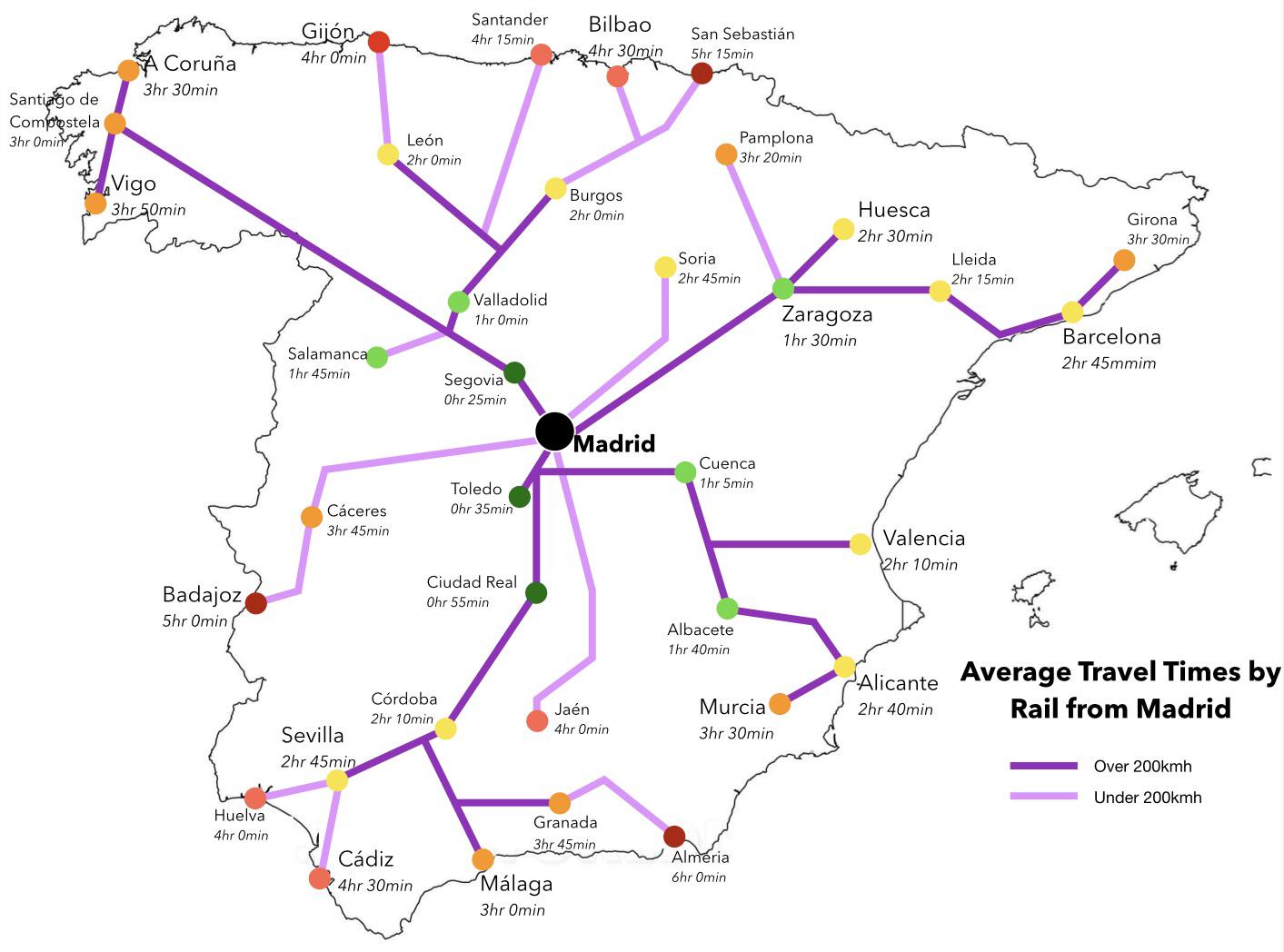Average Travel Times by Rail from Madrid Map


Marcus Rodriguez
Historical Geography Expert
Marcus Rodriguez specializes in historical cartography and geographic data analysis. With a background in both history and geography, he brings unique...
Geographic Analysis
What This Map Shows
The "Average Travel Times by Rail from Madrid" map visually represents the rail connectivity of Spain's capital, highlighting the time it takes to reach various destinations across the country. This visualization serves as a crucial tool for understanding the extensive rail network that connects Madrid to major cities, towns, and regional hubs. Knowing these travel times can significantly impact travel planning, whether for tourism, business, or personal visits.
Deep Dive into Rail Travel in Spain
Spain boasts one of the most developed rail networks in Europe, with high-speed trains, regional services, and an intricate web of local routes. The country's rail system is primarily operated by Renfe, which offers services ranging from the renowned AVE (Alta Velocidad Española) to local Cercanías trains.
High-speed rail travel in Spain has revolutionized how people move across the country. For instance, the AVE trains can reach speeds of up to 310 km/h (about 193 mph), making it possible to travel from Madrid to Barcelona in just over two and a half hours. This speed not only reduces travel time but also enhances convenience, making rail travel a preferred option over flying for many routes. Interestingly, the average time from Madrid to Valencia is just under two hours, which is significantly faster than driving.
Another important aspect of rail travel in Spain is its accessibility and affordability. The map likely illustrates average travel times to popular tourist destinations such as Seville, Málaga, and Bilbao, showcasing how rail travel makes these locations easily reachable. For example, a traveler can journey from Madrid to Seville in approximately two and a half hours, making it feasible for a day trip to explore the rich history and vibrant culture of Andalusia.
In addition to speed and accessibility, the rail network is also integral in reducing carbon emissions, as trains are a more environmentally friendly mode of transportation compared to cars and planes. Spain's commitment to sustainable travel is evident in its investment in high-speed rail, which has become a model for other countries looking to enhance their rail systems.
Regional Analysis
The map provides a detailed perspective on how Madrid serves as a hub for various regions. For example, the travel time to the Basque Country's capital, Bilbao, is around four hours. This relatively quick connection encourages both business and tourism, fostering economic ties between these regions.
Moreover, the average travel time to Galicia's capital, Santiago de Compostela, is approximately five hours. While this may seem longer, it still presents a viable option compared to other forms of transportation, especially when considering the scenic views along the way. One can’t help but notice how each region's unique characteristics are well-represented in the average travel times.
In contrast, destinations like Albacete or Toledo only take about an hour to reach, underlining the importance of regional connectivity for daily commuters and local economies. This balance between short and long-distance travel opportunities makes Madrid an essential node in Spain's transportation network.
Significance and Impact
Understanding average travel times by rail from Madrid is vital for several reasons. Firstly, it reflects Spain's commitment to enhancing its infrastructure and promoting rail travel as a sustainable alternative. As urbanization continues to grow, the efficiency of public transport will play a crucial role in managing traffic congestion and reducing carbon footprints.
Moreover, the implications extend beyond tourism; businesses benefit from swift rail connections, enabling quicker access to markets and clients. In recent years, there has been a notable increase in investment in rail infrastructure, aimed at expanding services to underserved areas and improving the overall quality of travel.
Looking towards the future, trends indicate that high-speed rail will continue to expand, with potential routes to connect with other European networks, enhancing Madrid's role as a central European transport hub. Additionally, as remote work becomes more prevalent, the convenience of rail travel may encourage people to live further away from their places of employment.
In conclusion, the "Average Travel Times by Rail from Madrid" map is not just a tool for navigation; it encapsulates the broader narrative of Spain's evolving transport landscape, highlighting the significance of rail travel in connecting people and places while fostering economic growth and sustainability.
Visualization Details
- Published
- September 15, 2025
- Views
- 90
Comments
Loading comments...